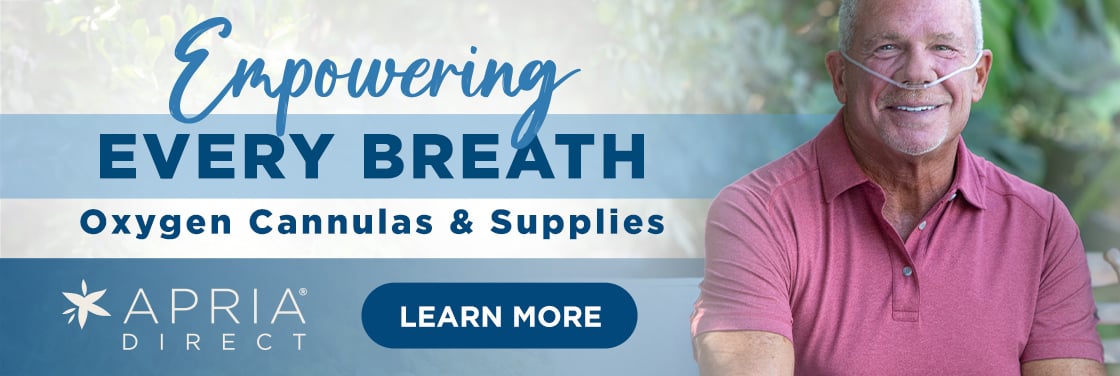How They Work, How to Maintain Them, and Why They’re Important For People With COPD.
Respiratory conditions such as COPD (chronic obstructive pulmonary disease) make breathing difficult, which deprives people of the much-needed oxygen that’s vital to organs throughout their body.
Low oxygen levels can lead to shortness of breath (dyspnea), headaches, coughing and wheezing, rapid breathing and heart rate (tachycardia), and confusion.
But there’s a proven treatment to help ensure you get the oxygen you need: oxygen therapy (also called supplemental oxygen).
Nasal cannulas play an important role in oxygen therapy.
How Nasal Cannulas Work
Nasal cannulas are the most common method to deliver oxygen. Unlike a facemask, also used to deliver oxygen, nasal cannulas let you eat and speak freely. They can be used in a hospital, at home, or during travel.
A nasal cannula is a thin, flexible tube that hooks over your ears. On one end are two prongs that you insert into your nostrils. The other end hooks up to an oxygen delivery system. Depending on your condition, your doctor may prescribe one or a combination of the following:
- Compressed oxygen stores oxygen in a metal tank as gas under pressure
- Oxygen concentrators separate and remove nitrogen from the air around you to deliver purified oxygen
Nasal Cannulas Are Used For Many Respiratory Conditions
- COPD (chronic obstructive pulmonary disease)
- Asthma, bronchitis, or emphysema
- Lung cancer
- Pneumonia
- Pulmonary fibrosis
- Congestive heart failure
- Cystic fibrosis
- COVID-19
- Bronchopulmonary dysplasia (underdeveloped lungs in newborns)
Two Types of Nasal Cannulas
There are high-flow and low-flow nasal cannulas. The primary difference is the amount of oxygen they deliver, which is measured in liters per minute.
Your doctor determines which is best for you and how much oxygen you need.
High-flow nasal cannulas
These can deliver up to about 60 liters of oxygen per minute. Because higher flow rates can dry out your nasal passages and cause nosebleeds, high-flow cannulas deliver warm, humidified oxygen.
Low-flow nasal cannulas
These have a flow rate of 4-6 liters of oxygen per minute. The oxygen isn’t heated but can be humidified if needed. There’s a risk that low-flow cannulas can cause bleeding or irritation to nasal passages.
The Benefits of Nasal Cannulas
- Cannulas allow for a large flow range, from 0.5 liters per minute up to 6 liters per minute
- They’re low profile and allow patients to talk and/or eat while simultaneously wearing oxygen.
- They’re easily maintained and inexpensive.
- They come in various sizes and lengths.
- Cannulas are less likely to move or need adjustments when in use.
The Risks of Nasal Cannulas
Like any therapy, nasal cannulas do pose some risks:
- As mentioned, nasal dryness or irritation. High-flow cannulas warm and humidify the oxygen to prevent this. Saline sprays may also help to ease dryness.
- Dry mouth
- Reduced sense of taste or smell
- Congestion or runny nose
- Cough
- Oxygen toxicity (also called oxygen poisoning), which can slow your breathing and heart rate to dangerous levels
Caring for Your Nasal Cannula and Supplies
To ensure your therapy is as safe and effective as possible, it’s important that you clean and care for your nasal cannula and other oxygen therapy supplies.
Check with the manufacturer for specific recommendations. But here are some general rules to follow.
Cleaning and changing your nasal cannula
Cleaning helps prevent the buildup of bacteria, mold, dust, and germs, which can cause respiratory infections and be dangerous for people with COPD.
Nasal cannula prongs that fit in your nose should be washed at least once a week. Wash in warm, soapy water then rinse well with hot water, and hang to dry.
If you notice any mucus buildup, clean more often.
You should also replace your cannula every 2-4 weeks—and change them every time you get sick.
Maintaining your extension tubing
This is the tubing that connects your nasal cannula to your oxygen source.
Extension tubing should never be washed or submerged in water, which can cause mold to form inside it. Instead, wipe the outside of the tubing.
Replace extension tubing every 2 months. Check frequently for any blockages or leaks. If you see tears or cracks, replace with new tubing immediately.
Maintaining your other oxygen therapy equipment
To prevent the formation of mold or bacteria, regularly clean your compressed oxygen or liquid oxygen tank, oxygen concentrator, and humidifier.
And remember: oxygen is highly flammable and can cause a fire to spread faster than usual. So keep your oxygen equipment away from open flames.
For more information: How to Properly Clean Your Oxygen Therapy Equipment
How to Get a Nasal Cannula
Even though oxygen is all around us, when it is used therapeutically, it is considered a drug. That’s why nasal cannulas and oxygen therapy require a prescription from your doctor.
Your doctor will measure your oxygen levels to determine if a prescription is necessary. You may also be prescribed a facemask rather than a nasal cannula in case you need higher amounts of oxygen.
The Nose Knows
With the help of nasal cannulas, you can increase the amount of oxygen delivered to your body—and improve your quality of life and overall well-being. Speak with your doctor about the type of cannula that may be right for you. And breathe more easily!
References
1. (2023, August 4). Nasal Cannula. Cleveland Clinic. https://my.clevelandclinic.org/health/treatments/25187-nasal-cannula.
2. Segal, D. (2021, November 11). What Is a Nasal Cannula? WebMD. https://www.webmd.com/lung/what-is-a-nasal-cannula.
3. Leader, D. (Updated 2023, November 13). An Overview of Nasal Cannulas. Verywell Health. https://www.verywellhealth.com/nasal-cannulas-914867.
4. Heitz, D. (Updated 2017, July 9). Nasal Cannulas and Face Masks. Healthline. https://www.healthline.com/health/nasal-cannulas-and-face-masks#1.
5. Sharma S, Danckers M, Sanghavi DK, Chakraborty RK. High-Flow Nasal Cannula. 2023 Apr 6. In: StatPearls [Internet]. Treasure Island (FL): StatPearls Publishing; 2023 Jan. PMID: 30252327.
LEGAL DISCLAIMER: Material in this newsletter is provided for general health education and informational purposes and to provide references to other resources only; it may not apply to you as an individual. While Apria Healthcare believes that the information provided through this communication is accurate and reliable, Apria Healthcare cannot and does not make any such guarantee. It is not intended to be a replacement for professional medical advice, evaluation, diagnosis, services or treatment (collectively, “medical treatment”). Please see your healthcare provider for medical treatment related to you and your specific health condition(s). Never disregard medical advice or delay seeking medical care because of something you have read on or accessed through this website. Reading this newsletter should not be construed to mean that you have a healthcare provider/patient relationship.


.png)



